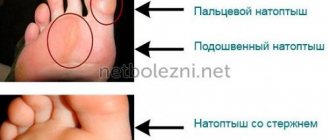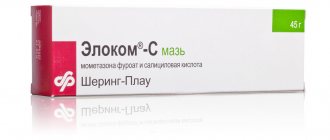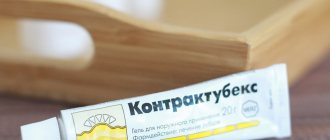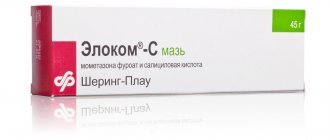Pharmacological properties
Hydrocortisone in the composition of the drug is a natural glucocorticosteroid. It has anti-inflammatory, antiallergic, antipruritic and anti-edematous effects. Stabilizes cellular (subcellular) membranes of mast cells, lysosome membranes. Inhibits the alteration phase, reduces cellular infiltrates of inflammation, suppresses the migration of inflammatory mediators to the site of the lesion. Reduces the binding of immunoglobulins and receptors on the cell surface, blocks the synthesis and release of cytokines from macrophages and lymphocytes. Reduces the synthesis of arachidonic acid metabolites (prostaglandins, leukotrienes, thromboxane). Inhibits the exudation reaction, reduces capillary permeability. Levels the severity of the immunological response. Induces the formation of lipocortins with anti-edematous activity. It exhibits antimetabolic effect, inhibits the proliferation of connective tissue, collagen deposits, and scarring. When used in therapeutic doses, it has almost no systemic effect.
Hydrocortisone ointment for external use 1% 10g
Compound
Active substance: hydrocortisone acetate - 1 g. Excipients: petrolatum - 45 g, lanolin - 10 g, pentaerythrityl dioleate - 5 g, stearic acid - 3 g, methyl parahydroxybenzoate - 0.08 g, propyl parahydroxybenzoate - 0.02 g, water - up to 100 g.
Pharmacokinetics
Suction
After application, the active substance accumulates in the epidermis, mainly in the granular layer; systemic absorption is negligible. A small amount of hydrocortisone is absorbed into the systemic circulation unchanged.
Metabolism
Most of hydrocortisone is metabolized directly in the epidermis and subsequently in the liver.
Removal
Metabolites and a small part of unchanged hydrocortisone are excreted by the kidneys and through the intestines.
Indications for use
For external use: allergic dermatitis, seborrhea, various forms of eczema, neurodermatitis, psoriasis, prurigo, lichen planus.
If necessary, please consult your doctor before using the medicine.
Contraindications
For short-term use for health reasons - increased sensitivity to hydrocortisone.
For external use: bacterial, viral, fungal skin diseases, skin tuberculosis, skin manifestations of syphilis, skin tumors, post-vaccination period, violation of the integrity of the skin (ulcers, wounds), children's age (up to 2 years, with itching in the anus - up to 12 years), rosacea, acne vulgaris, perioral dermatitis.
Directions for use and doses
Externally. The drug is preferably used for acute and subacute skin processes (without weeping).
The drug is applied to the affected areas of the skin in a thin layer 1-3 times a day. To improve penetration, the drug is applied with light massaging movements. If positive dynamics appear, the frequency of use of the drug can be reduced to 2-3 times a week. The course of treatment is 1-3 weeks. In children, the course of treatment should not exceed 7 days.
If there is no improvement after treatment or new symptoms appear, you should consult your doctor. Use the drug only according to the method of use and in the doses indicated in the instructions. If necessary, please consult your doctor before using the medicine.
Storage conditions
Store out of the reach of children at a temperature not exceeding 25°C.
Best before date
3 years. Do not use the drug after the expiration date.
special instructions
If there are signs of hypersensitivity or skin irritation associated with the use of the drug, you should stop treatment and consult a doctor. With prolonged treatment, when applying the drug to large surfaces of the skin, when using occlusive dressings, as well as in children, systemic absorption of the glucocorticosteroid is possible; it is possible to suppress the function of the hypothalamic-pituitary-adrenal system and develop symptoms of hypercortisolism.
Atrophic changes may appear on the skin of the face more often than on other surfaces of the body after long-term treatment with topical glucocorticosteroids; the course of treatment in this case should not exceed 5 days.
Care must be taken when applying the drug to the face, folds, natural folds, and areas with thin skin.
Avoid getting the drug into your eyes. Do not apply the drug to mucous membranes. It should be borne in mind that glucocorticosteroids can change the manifestations of some skin diseases, which can make diagnosis difficult. In addition, the use of glucocorticosteroids may delay wound healing.
With long-term therapy with glucocorticosteroids, sudden cessation of therapy can lead to the development of rebound syndrome, which manifests itself in the form of dermatitis with intense redness of the skin and a burning sensation. Therefore, after long-term treatment, drug withdrawal should be carried out gradually, for example, by switching to an intermittent treatment regimen before stopping it completely. Propyl parahydroxybenzoate, which is part of the drug, can cause allergic reactions (possibly delayed type). In such cases, you should stop using the drug.
Use in pediatrics
The drug can be used in children from 2 years of age. It must be taken into account that in young children, skin folds, diapers, and diapers can have an effect similar to the effect of an occlusive dressing and increase the systemic resorption of glucocorticosteroids. In addition, in children, a greater degree of systemic resorption is possible due to the relationship between the surface of the skin and body weight, as well as due to insufficient skin maturity. Long-term treatment of children with glucocorticosteroids can lead to disturbances in their growth and development. Therefore, long-term use of the drug should be carried out under the supervision of a physician. Children should receive the minimum dose of the drug sufficient to achieve an effect. In children, the course of treatment should not exceed 7 days.
Description
Glucocorticosteroid for local use.
Dosage form
Ointment for external use 1% from white with a yellowish tint to light yellow, with a characteristic odor.
Use in children
Contraindications for external use: children under 2 years of age, for itching in the anus - up to 12 years.
Pharmacodynamics
GKS. Suppresses the functions of leukocytes and tissue macrophages. Limits the migration of leukocytes to the area of inflammation. It disrupts the ability of macrophages to phagocytose, as well as to form interleukin-1. Helps stabilize lysosomal membranes, thereby reducing the concentration of proteolytic enzymes in the area of inflammation. Reduces capillary permeability due to the release of histamine. Suppresses fibroblast activity and collagen formation.
Inhibits the activity of phospholipase A2, which leads to suppression of the synthesis of prostaglandins and leukotrienes. Suppresses the release of COX (mainly COX-2), which also helps to reduce the production of prostaglandins.
Reduces the number of circulating lymphocytes (T- and B-cells), monocytes, eosinophils and basophils due to their movement from the vascular bed into the lymphoid tissue; suppresses the formation of antibodies.
Hydrocortisone suppresses the release of ACTH and β-lipotropin by the pituitary gland, but does not reduce the level of circulating β-endorphin. Inhibits the secretion of TSH and FSH.
When directly applied to blood vessels, it has a vasoconstrictor effect.
Hydrocortisone has a pronounced dose-dependent effect on the metabolism of carbohydrates, proteins and fats. Stimulates gluconeogenesis, promotes the uptake of amino acids by the liver and kidneys and increases the activity of gluconeogenesis enzymes. In the liver, hydrocortisone enhances the deposition of glycogen, stimulating the activity of glycogen synthetase and the synthesis of glucose from protein metabolism products. An increase in blood glucose levels activates the release of insulin.
Hydrocortisone inhibits the uptake of glucose into fat cells, which leads to activation of lipolysis. However, due to increased insulin secretion, lipogenesis is stimulated, which leads to fat accumulation.
It has a catabolic effect in lymphoid and connective tissue, muscles, adipose tissue, skin, bone tissue. To a lesser extent than mineralocorticoids, it affects the processes of water-electrolyte metabolism: it promotes the excretion of potassium and calcium ions, the retention of sodium and water ions in the body. Osteoporosis and Itsenko-Cushing syndrome are the main factors limiting long-term GCS therapy. As a result of the catabolic effect, growth suppression in children is possible.
In high doses, hydrocortisone can increase the excitability of brain tissue and help lower the seizure threshold. Stimulates excess production of hydrochloric acid and pepsin in the stomach, which contributes to the development of peptic ulcers.
When applied externally and locally, the therapeutic activity of hydrocortisone is due to its anti-inflammatory, antiallergic and antiexudative (due to the vasoconstrictor effect) effect.
Its anti-inflammatory activity is 4 times weaker than prednisolone, and its mineralocorticoid activity is superior to other corticosteroids.
Side effects
Hyperemia, swelling, itching and irritation of the skin where the ointment is applied.
With long-term use of glucocorticosteroids, the development of secondary infectious skin lesions, atrophic changes, and hypertrichosis is possible.
When applied to large surfaces and/or using occlusion, the development of symptoms of hypercortisolism (hyperglycemia, glucosuria, reversible inhibition of adrenal function, manifestation of Itsenko-Cushing syndrome) is possible, as a manifestation of the resorptive effect of hydrocortisone.
If any of the side effects indicated in the instructions worsen, or any other side effects not listed in the instructions are noted, you should immediately inform your doctor.
Use during pregnancy and breastfeeding
Use during pregnancy is possible only when the expected benefit to the mother outweighs the potential risk to the fetus; It is recommended to use minimal doses and short-term therapy. Children whose mothers received hydrocortisone during pregnancy should be closely monitored for signs of adrenal insufficiency.
If it is necessary to use it during lactation, the issue of stopping breastfeeding should be decided.
Experimental studies have shown that GCS can cause fetal developmental disorders. There is currently no clear confirmation of these data in humans.
Interaction
No interaction of hydrocortisone when used externally with other drugs has been identified.
Overdose
Acute overdose is unlikely, however, when using the drug on large areas of affected skin with increased capacity for resorption, for a long time or using an occlusive dressing, chronic overdose is possible, accompanied by signs of hypercortisolism.
Treatment: symptomatic, if necessary, correction of water and electrolyte balance, drug withdrawal (with long-term therapy - gradual withdrawal).
Release form
Ointment for external use 1% 10g.
Impact on the ability to drive vehicles and operate machinery
The drug does not affect the ability to drive vehicles or perform other potentially hazardous activities.
Contraindications
- Reactions of individual intolerance.
- Viral and fungal infectious diseases of the eyes.
- Trachoma.
- Tuberculosis.
- Violations of the integrity of the corneal epithelium.
- Vaccination period.
- Breastfeeding period.
Hydrocortisone ophthalmic ointment should be used with caution in patients with diabetes and hypertension.
For pregnant women, the drug is prescribed according to strict indications and is used for no more than 7-10 days.



